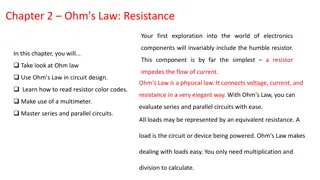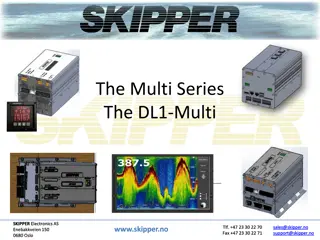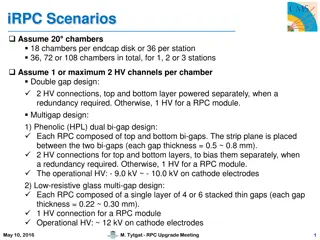Electronics and Control Systems Chapter 10
The chapter delves into PWM systems, discussing counter and compare values, PWM signal outputs, various PWM signals with different duty cycles and frequencies, the impact of system configuration on flow rate in a centrifugal pump, different communication topologies in sprayers, and lightbar-assisted guidance displays. It emphasizes the importance of measuring what you want to control in a control system and highlights the benefits of ISOBUS in farm operations for mixed-manufacturer setups and simplified data collection.
Download Presentation

Please find below an Image/Link to download the presentation.
The content on the website is provided AS IS for your information and personal use only. It may not be sold, licensed, or shared on other websites without obtaining consent from the author. Download presentation by click this link. If you encounter any issues during the download, it is possible that the publisher has removed the file from their server.
E N D
Presentation Transcript
Electronics and Control Systems Chapter 10
Fig. 10.1. a) The counter and compare values for a PWM system with BOTTOM = 0 and TOP = 255, 1 ms counter rate, 0.256 s period, and 3.906 Hz frequency; b) the resulting PWM signal output. Note that this is synchronized PWM update, since the COMPARE value is only effectively changed at the beginning of each period.
Fig. 10.2. Three PWM signals: a) 50% duty cycle, 1 Hz frequency, 1 s period, b) 20% Duty Cycle, 10 Hz frequency, 100 ms period, and c) 90% Duty Cycle, 5 Hz frequency, and 200 ms period.
Fig. 10.3. The flowrate of a centrifugal pump depends on both the pump curve and the system curve. Changes to the system configuration change the system curve, which could fall between the two red dashed lines. When a servo valve is adjusted to control flowrate, it also effects the pressure at the nozzles and can negatively impact droplet size. The red hatched area represents the possible system curves depending on servo valve setting.
Fig. 10.4. a) A sprayer with optical canopy sensors wired in a Bus topology; b) an older, traditional serial communication sprayer wired in a Star topology. In the star configuration, all ECUs that need to communicate with eachother require a direct connection. With the bus configuration, all communication is shared on the same wires, greatly simplifying the wiring harnesses and enabling easier data collection.
Fig. 10.5. Lightbar assisted guidance display. The LED indicators and map both suggest that that the vehicle is to the right of the desired path. The operator should correct the course by turning the steering wheel to the left.
Summary In every control system, the first requirement in achieving controllability is that you must be able to measure what you want to control, from liquid application to seed placement and everything in between. ISOBUS has improved the ability of farmers to choose mixed-manufacturer operations, and also greatly simplified the tasks of farm data collection from machinery operations.
Video 10.1. How do control systems improve the application of agricultural inputs? http://bit.ly/control-systems-application Video 10.2. Why is sprayer boom height control important? http://bit.ly/sprayer-boom- height Video 10.3. How does automated boom height control work? http://bit.ly/automated- boom-height Video 10.4. How does GPS auto-guidance create value for a farmer? http://bit.ly/GPS- auto-guidance
Problems What types of electrical signals would you expect to as the output of a sensor? In open-loop control, why can we not be certain that the speed or rate of an actuator is at its desired value? In a closed-loop control system, what is the setpoint? How is it related to the error? Thought experiment: Open-loop control using feedback is never guaranteed to exactly meet the setpoint if only proportional gain is applied to the error. Which gain, integral or derivative, would need to be added to the system to ensure the setpoint is reached? What are the benefits and drawbacks of liquid sprayer system with a servo valve to control flow rate? Why is it possible to control flowrate on a conventional nozzle based liquid application system only by changing the pressure relief valve? Why is manure less likely to be applied in a variable-rate manner when compared to granular or liquid based fertilizers? List at least three reasons why it is difficult to apply anhydrous ammonia fertilizer in a variable-rate manner. If you had a PWM controller that incremented its counter 16 million times per second, what would the maximum PWM resolution be if you wanted the frequency to be 20 kHz? What would the BOTTOM and TOP counter values need to be set at? How are lightbar guidance and auto-steer guidance similar? What is the major difference? How could the two technologies improve efficiency in a tillage operation? What are two major benefits of ISOBUS using a bus network topology instead of a star topology? (at least two) How does implement steering improve the potential accuracy of product and seed placement? How can improved seed placement and seed meter monitoring improve yields? What is the Universal Terminal in an ISOBUS system? What are the advantages of filtering messages in an ISOBUS system?
Precision Variable Equipment Chapter 11
Abstract Abstract In precision agriculture, variable rate equipment is used to variably apply site-specific prescriptions. The information used to vary the rates can be based on maps created from scouting reports, yield monitor files, and remote sensing data. Different types of information are used for different problems. For example, to vary seeding rates, archived yield monitor data files may be used to build management zone seeding rate maps, whereas the collection and real-time processing of crop reflectance information may be used to vary in-season nitrogen rates. Regardless of the approach, all precision variable rate systems require the collection of accurate information, proper configuration of location and guidance systems, and calibration of equipment used to apply the treatments. Because the calculations used to determine the desired rate are of no concern to the equipment, all calculations must be checked for accuracy. The equipment will do what it is communicated by either the map-based prescription or the on-the-go sensor readings taken in the field. This chapter discusses opportunities for variable rate equipment, recent options for variably applying seeds, pesticides, and fertilizers, recent advances in variable rate equipment, the basic components of variable rate equipment, and future research needs.
Fig. 11.1. An example evapotranspiration (ET) map is shown on the left, with a corresponding yield map from the same field shown on the right (Mishra et al., 2008). Area with low yields (yellow in right image) were water stressed and had low yields, typically in the ridge or shoulder areas of the field.
Fig. 11.2. Flow charts and control methodologies for map-based and sensor-based strategies.
Fig. 11.3. White mold in a South Dakota production field (left). The center image was collected with a UAV and the right image was collected with the Landsat satellite. These images show that the ability to detect differences depends on spectral resolution (Clay et al., 2017a)
Fig. 11.4. A typical microprocessor based rate control system.
Fig. 11.5. Overview of the typical components and setup for a sprayer equipped with automatic section control.
Fig. 11.6. Nozzle On-state time variation during 40% (left) and 80% (right) duty cycle with a 10 Hz (100 ms cycle) PWM system.
Fig. 11.7. An electric motor with planetary gearbox and RCM integrated for seed metering
Fig. 11.8. An example multi-hybrid planter row unit.
Fig. 11.9. Metering control mechanism with encoder (within red circle) and proportional PWM (within yellow circle) valve (left) and apron chain (within blue circle) for metering product (right) for a pneumatic spreader.
Fig. 11.10. Example of potential sector (or speed) control irrigation application depth control areas (differing shades of blue) at 10 degree increments.
Fig. 11.11. Example of potential zone pivot irrigation application depth control areas (differing shades of blue) at 10 degree increments with banks or sections of sprinkler controlled along the pivot lateral.
Fig. 11.12. Example of potential zone pivot irrigation application depth control areas (differing shades of blue) at 10 degree increments with individual sprinkler control along the pivot lateral.
Video 11.1. How might site-specific nutrient management approaches improve our understanding of crop nutrient management? http://bit.ly/site- specific-management Video 11.2. Variable rate aerial application. http://bit.ly/variable-rate-aerial Video 11.3. How is variable-rate fertilizer management going to change? http://bit.ly/fertilizer-management
Summary Summary Since 1990, precision variable-rate equipment has become more accurate and easier to operate. In spite of these advances, there is a long way to travel before the systems become automatic. This chapter provided a discussion of current system, as well as topics that are being researched.
Study Questions Study Questions What are the questions are best suited for real-time sensing and application? What type of questions are best suited for mapped-based applications? Why does water, either too much or too little influence yield or the application of VRA? How does flow-based and pressure-based control systems differ? Explain how variable cultivar seeding is accomplished.























